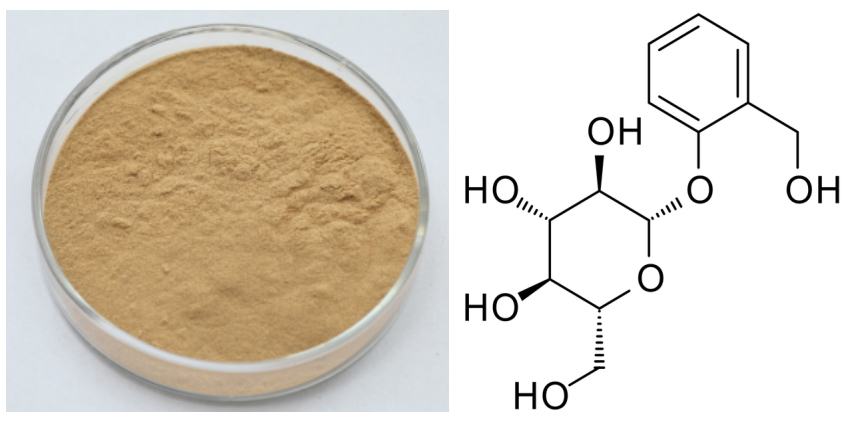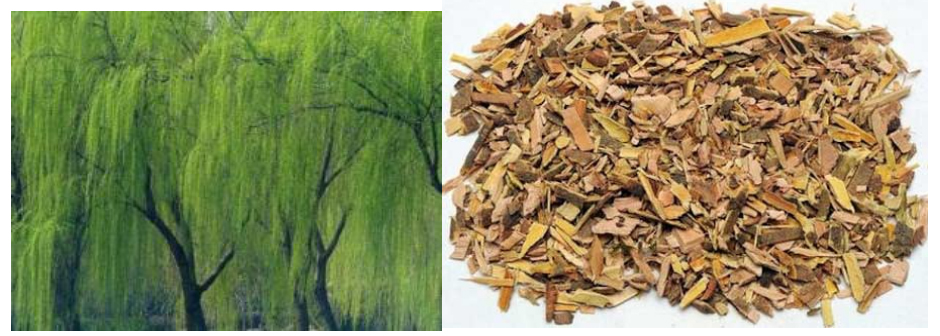Cheapest Price White Willow Bark Extract Factory from Norway
Cheapest Price White Willow Bark Extract Factory from Norway Detail:
[Latin Name] Salix alba L.
[Plant Source] from China
[Specifications] Salicin 15-98%
[Appearance] Yellow Brown to White powder
Plant Part Used: Bark
[Particle size] 80 Mesh
[Loss on drying] ≤5.0%
[Heavy Metal] ≤10PPM
[Storage] Store in cool & dry area, keep away from the direct light and heat.
[Shelf life] 24 Months
[Package] Packed in paper-drums and two plastic-bags inside.
[Net weight] 25kgs/drum
Brief Introduction
Salicin is a naturally occurring compound found in the bark of several species of trees, primarily North American in origin, that are from the willow, poplar, and aspen families. White willow, from whose Latin name, Salix alba, the term salicin is derived, is the most well known source of this compound, but it is found in a number of other trees, shrubs, and herbaceous plants as well being synthesized commercially. It is a member of the glucoside family of chemicals and is used as an analgesic and antipyretic. Salicin is used as a precursor for the synthesis of salicylic acid and acetylsalicylic acid, commonly known as aspirin.
A colorless, crystalline solid in its pure form, salicin has the chemical formula C13H18O7. Part of its chemical structure is equivalent to the sugar glucose, meaning it is classified as a glucoside. It is soluble, but not strongly so, in water and alcolhol. Salicin has a bitter taste and is a natural analgesic and antipyretic, or fever reducer. In large quantities, it can be toxic, and overdoses may lead to liver and kidney damage. In its raw form, it may be mildly irritating to skin, respiratory organs, and eyes.
Function
1. Salicin is used to ease pain and reduce inflammation.
2. Relieve acute and chronic pain, including headache, back and neck pain, muscle aches, and menstrual cramps; Control arthritis discomforts.
3. Relieve acute and chronic pain.
4. It has the same effect on the body as aspirin without any of the side effects.
5. It is an anti-inflammatory, a fever reducer, an analgesic, an anti-rheumatic, and an astringent. Specifically, it helps to relieve headaches.
Application
1.Anti-inflammatory, anti-rheumatic,
2.Reduce a fever,
3.Use as an analgesic and astringent,
4.Relieve headache,
5.Ease pain caused by rheumatism, arthritis, and carpal tunnel syndrome.
Product detail pictures:

Related Product Guide:
Assume full duty to satisfy all demands of our clients; reach steady advancements by marketing the development of our purchasers; grow to be the final permanent cooperative partner of clientele and maximize the interests of customers for Cheapest Price White Willow Bark Extract Factory from Norway , The product will supply to all over the world, such as: Leicester, Jordan, Singapore, Our company will continue to adhere to the " superior quality, reputable, the user first " principle wholeheartedly. We warmly welcome friends from all walks of life to visit and give guidance, work together and create a brilliant future!
Fig fruit tree is native to temperate climate of Asia Minor or present day Turkey and today is grown as important fruit of commerce in the eastern Mediterranean region, USA, Spain. However, it is also cultivated as a fruit tree in home gardens. During each season, the tree bears several hundred pear-shaped fruits twice a year, which vary in size and color depending on the variety.
Interiorly, the fig fruit features numerous club shaped ovaries protruding towards central hollow cavity. In their natural habitat, “caprifigs” are pollinated by a tiny gall wasp (Blastophaga grossorum) that enters the flower cluster through a small opening in the apex.
Several cultivars exist; some of the popular varieties commonly grown in the USA are Brown Turkey, Conadria, Kadota, and Black mission. However, since the wasp is not present in North America, most of these fruits do not have true seeds, and they develop by parthenogenesis (without pollination).
Health benefits of figs
Fig fruit is low in calories. 100 g fresh fruits provide only 74 calories. However, they contain health benefiting soluble dietary fiber, minerals, vitamins, and pigment anti-oxidants that contribute immensely for optimum health and wellness.
Dried figs are an excellent source of minerals, vitamins and anti-oxidants. In fact, dried fruits are concentrated sources of energy. 100 g dried figs provide 249 calories.
Fresh figs, especially black mission, are good in poly-phenolic flavonoid anti-oxidants such as carotenes, lutein, tannins, chlorogenic acid…etc. Their anti-oxidant value is comparable to that of apples at 3200 umol/100 g.
In addition, fresh fruits contain adequate levels of some of the anti-oxidant vitamins such as vitamin A, E, and K. Altogether these phyto-chemical compounds in fig fruit help scavenge harmful oxygen derived free radicals from the body and thereby protect us from cancers, diabetes, degenerative diseases and infections.
Furthermore, research studies suggest that chlorogenic acid in these berries help lower blood sugar levels and control blood-glucose levels in type-II diabetes mellitus (Adult onset) condition.
Fresh, as well as dried figs contain good levels of B-complex group of vitamins such as niacin, pyridoxine, folates, and pantothenic acid. These vitamins function as co-factors for metabolism of carbohydrates, proteins, and fats.
Dried figs are an excellent sources of minerals like calcium, copper, potassium, manganese, iron, selenium and zinc. 100 g of dried figs contain 640 mg of potassium, 162 mg of calcium, 2.03 mg of iron and 232 mg of potassium. Potassium is an important component of cell and body fluids that helps controlling heart rate and blood pressure. Copper is required in the production of red blood cells. Iron is required for red blood cell formation as well for cellular oxidation.
Troy Casey, Certified Health Nut, researching herbal medicine with Shipibo in the Amazon Rain Forest. https://certifiedhealthnut.com https://workingwithtroy.com
***SHOP @ The CHN SUPERFOOD STORE*** Try the 10 day transformation cleanse or boost your nutrition with ORGANIC, nonGMO Green super foods and herbs: https://www.phporder.com/Transformation.aspx?ID=healthnut
The information contained in this video is intended for educational purposes only. It is not intended to diagnose, cure, mitigate, treat or prevent any disease. If you have any health concern, it is recommended to seek the advise of a certified health practitioner.
In May, 1994, the World Health Organization sponsored the first international conference on Uña de Gato in Geneva, Switzerland. At the conference, Uña de Gato was recognized as one of the most important medicinal plants of the whole world pharmacopoeia. The oxindole alkaloids found in the bark and roots of Uña de Gato have so far drawn the greatest attention for their effect on the immune system. A scientist, Dr. Klause Keplinger made their discovery in the 1980s.
attention has been drawn on chanca piedra in the early 1980s after the report of its beneficial effect on hepatitis B. Subsequent studies provided mitigated results, probably due to variations in strains, origin and process of extraction. However, in 1992 a Japanese group discovered that a simple water extract of chanca piedra contained a compound able to inhibit an enzyme called reverse transcriptase. Reverse transcriptase is an enzyme involved in the process of virus replication.
A recent scientific study revealed that nearly 90% of dried Sangre de Drago sap was composed of one of the most potent antioxidants, proanthocyanidin, also known as Pycnogenol® and grape seed extract. This strong presence of antioxidant activity may in part explain the effect of Sangre de Drago on colitis and other digestive disorders, by reducing inflammation in the intestinal mucosa. The high concentration of bitter bioflavonoids proanthocyanidins are bioflavonoids- in Sangre de Drago may explain its action of intestinal parasite. It is also noteworthy that a U.S.-based pharmaceutical company has developed two pharmaceutical drugs that contain antiviral constituents isolated and extracted from the bark and resin of Sangre de Drago.
Many studies published in the past few years have revealed the health promoting properties of cacao, especially on the cardiovascular system. The flavonoids found in cacao were shown to inhibit platelet activation, one of the main causes of stroke and cardiac infarction. Proanthocyanidins derived from cacao were shown to inhibit diabetes-induced cataract formation, possibly by virtue of their antioxidant activity. One study concluded that cocoa powder and dark chocolate favorably affect cardiovascular disease risk status by modestly reducing LDL oxidation susceptibility, and increasing serum total antioxidant capacity and HDL-cholesterol concentrations.
https://tiny.cc/rv5puw
https://www.trivita.com/Web/US/content/products/category.aspx?id=3004&sid=10844&mid=104&tref=14335246
The company's products can meet our diverse needs, and the price is cheap, the most important is that the quality is also very nice.







